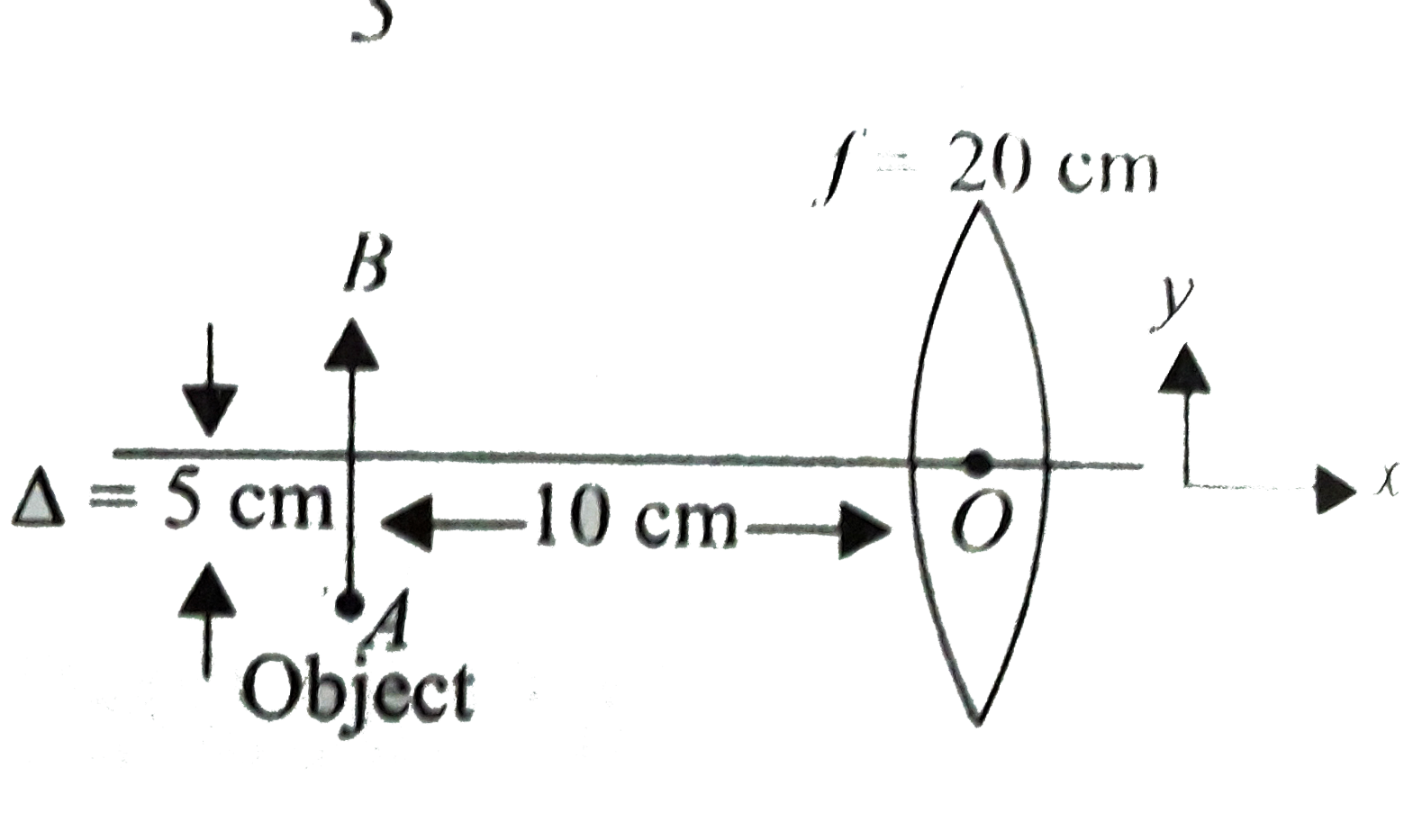A linear object of size 1.5cm is placed at 10 cm from a lens of focal length 20 cm. The optic centre of lens and the object are displaced are displaced a distance Δ. Thed magnification of the image formed is m. (Take optic centre of origin). The coordinates of image of A and B are (x1,y1) and (x2,y2) respectively then

(x1,y1)=(−20cm,−2cm)
(x2,y2)=(−20cm,2cm)
m=5
m=4
The correct Answer is:B
u=−0cm,f=20cm

1v−1u=1f,1v=120−110=−120⇒v=−20cm
Magnification, m=vu=−20−10=2
Height of image =1.5×2=3cm
The y1 coordinate of a point A on the image will be
y1=(−0.5)×2=−1cm
The y2 coordinate of a point B on the image will be
y2=1×2=2cm
Topper's Solved these Questions
- RAY OPTICS AND OPTICAL INSTRUMENTSBOOK - NCERT FINGERTIPSCHAPTER - RAY OPTICS AND OPTICAL INSTRUMENTSEXERCISE - NCERT Exemplar
11 Videos
- RAY OPTICS AND OPTICAL INSTRUMENTSBOOK - NCERT FINGERTIPSCHAPTER - RAY OPTICS AND OPTICAL INSTRUMENTSEXERCISE - Assertion And Reason
15 Videos
- RAY OPTICS AND OPTICAL INSTRUMENTSBOOK - NCERT FINGERTIPSCHAPTER - RAY OPTICS AND OPTICAL INSTRUMENTSEXERCISE - Miscellaneous
9 Videos
- PRACTICE PAPPERBOOK - NCERT FINGERTIPSCHAPTER - PRACTICE PAPPEREXERCISE - Practice Paper 3
50 Videos
- SEMICONDUCTOR ELECTRONICS : MATERIALS , DEVICES AND SIMPLE CIRCUITS BOOK - NCERT FINGERTIPSCHAPTER - SEMICONDUCTOR ELECTRONICS : MATERIALS , DEVICES AND SIMPLE CIRCUITS EXERCISE - Assertion And Reason
15 Videos
Similar Questions
An object 4 cm high is placed at a distance of 10 cm from a convex lens of focal length 20 cm. Find the position, nature and size of the image.
View SolutionAn object is held at a distance of 20cm from a concave lens of focal length 80 cm. What is the position and size of the image if the object is 2 cm high ?
View Solution
Knowledge Check
A linear object of size 1.5cm placed at 10cm from a lens of focal length 20cm. The optic centre of lens and the object are displaced a distance Δ. The magnification of the image formed is m (Take optic centre as origin). The coordinates of image of A and B are (x1,y1) and (x2,y2) respectively. Then
 A(x1,y1)=(−20cm,−1cm)B(x2,y2)=(−20cm,2cm)Cm=3Dm=2
A(x1,y1)=(−20cm,−1cm)B(x2,y2)=(−20cm,2cm)Cm=3Dm=2An object is placed at a distance of 20 cm from a convex lens of focal length 10 cm . The image is formed on the other side of the lens at a distance
A20 cmB10 cmC40 cmD30 cmA 5 cm tall object is placed perpendicular to the principle axis of a convex lens of focal length 20 cm. The distance of the object from lens is 30 cm. Then, position and size of image formed is
AV= - 60 cm and h = 10 cmBV= + 60 cm and h = 10 cmCV= - 30 cm and h = 5 cmDV= + 60 cm and h = 5 cm
An object is situated at a distance of 10 cm from the optical centre of a convex lens of focal length 20 cm. The image formed on the screen is found to be an erect and enlarged image.
View SolutionAn object is placed at the focus of concave lens having focal length /. What is the magnification and distance of the image from the optical centre of the lens ?
View SolutionAn object of height 2.5 cm is placed at a distance of 15 cm from the optical centre 'O' of a convex lens of focal length 10 cm. Draw a ray diagram to find the position and size of the image formed. Mark optical centre 'O', principal focus F and height of the image on the diagram.
View SolutionAn object 1.5 cm high is placed 10 cm from the optical centre of a thin lens. Its image is formed 25 cm from the optical centre on the same side of the lens as the object. The height of the image is
View SolutionAn object of height 5 cm is placed perpendicular to the principal axis of a concave lens of focal length 10 cm. If the distance of the object from the optical centre of the lens is 20 cm. Position, nature and size of the image formed.
View Solution
